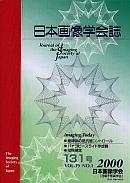All issues

Volume 43, Issue 2
Displaying 1-6 of 6 articles from this issue
- |<
- <
- 1
- >
- >|
Imaging Today
“Advanced Technologies for High Quality Color Image Output”
“Advanced Technologies for High Quality Color Image Output”
-
Hiroaki KOTERA2004Volume 43Issue 2 Pages 73-81
Published: 2004
Released on J-STAGE: July 01, 2006
JOURNAL FREE ACCESSThis paper comments a recent progress in the development of color system. Since a color is a common language to communicate the real world image, a color system plays an important role to jointly exchange a correct color. The major activities of CIE have been devoted to find the better uniform color space. The wide spread of internet has promoted a standardization of CMS (Color Management System). A strong demand for high-precision color control in industry stimulated a development of reliable color difference formula referred to as CIEDE2000 and a request for color appearance reproduction under the different environments in digital image application brought an introduction of CAM (Color Appearance Model)referred to as CIECAM02. CIE Technical Committees are working actively on the standardization of Imaging Technology under Div.8. Now, the newest TC8-08 is going to step into Spatial Color Appearance model. An excellent perceptual color system will be hopefully developed based on human color vision mechanism.View full abstractDownload PDF (903K) -
Hideki TANIZOE, Hiroaki SUGIURA2004Volume 43Issue 2 Pages 82-89
Published: 2004
Released on J-STAGE: July 01, 2006
JOURNAL FREE ACCESSIn these years, the sRGB which is the standard color space has been introduced to most of computer display in the market. The Liquid Crystal Display (LCD) is used to have less color gamut than Cathode Ray Tube (CRT) display, however recently some of LCD provides equal range of color gamut compare to CRT display. And because of the progress of imaging devices, ex. digital still camera and inkjet printer, we see revolution of workflow in related industries. This makes needs for more better performance of color reproduction in display.
This paper provides an introduction of the color conversion technology which is used in the display with less gamut than sRGB, as well as some interpretation of two type of wide color gamut displays provide the Adobe RGB color gamut, and back ground of development.
This research was organized in part by the New Energy and Industrial Technology Development Organization, Japan (NEDO).View full abstractDownload PDF (844K) -
Masato TSUKADA, Tetsuaki SUZUKI, Akira INOUE2004Volume 43Issue 2 Pages 90-97
Published: 2004
Released on J-STAGE: July 01, 2006
JOURNAL FREE ACCESSImage quality is a very important factor for digital imaging devices. Lighting conditions and image scene that affect to image quality vary hour after hour. It is hard to stably obtain high quality image by using an image correction method with previously fixed parameters. In order to solve the problem, we need an image correction technique for image quality-image saturation, contrast, white balance, sharpness, and preferred colors-that controls correction parameters adapting to image quality of input image. This article describes image-processing techniques to improve image quality by analyzing image contents and calculating optimal parameters. The techniques adaptively correct image quality depending on image quality of an input image. A smoothing technique of correction parameters, which is used for quality improvement of moving pictures, is also described.View full abstractDownload PDF (2759K) -
Haruo YAMASHITA2004Volume 43Issue 2 Pages 98-104
Published: 2004
Released on J-STAGE: July 01, 2006
JOURNAL FREE ACCESSWith the improvement in a performance of a digital camera, the quality-of-image-dissatisfaction for ordinary persons was lost and the home print by the photograph printer has been realized instead of the further conventional photograph. As a print system for a direct print which does not use PC, the sublimation-dye type thermal transfer system is excellent in terms of high-print-quality, good-picture-preservability, compact-equipment and non-maintenance.
This paper explains temperature compensation technology reproducing the stable density which was not concerned with ambient temperature and heat accumulations in a thermal head and color matching technology of having been suitable for the sublimation-dye printing as technology of especially relation to image quality of a sublimated type photograph printer.View full abstractDownload PDF (778K) -
Toshiaki KAKUTANI2004Volume 43Issue 2 Pages 105-111
Published: 2004
Released on J-STAGE: July 01, 2006
JOURNAL FREE ACCESSTwo halftone methods to get better distribution of multi level dots such as thick and thin ink dots or large, medium and small size dots are newly suggested. The 1st is an improvement of an error diffusion method which affords higher quality output, and it got The Prize of the Minister of Economy Trade and Industry at the 2003 National Commendation for Invention. The 2nd is an improvement of an ordered dither method which affords faster processing. The combination of these two methods is also available.View full abstractDownload PDF (837K) -
—Smoothing and Halftoning—Akira ISHII2004Volume 43Issue 2 Pages 112-118
Published: 2004
Released on J-STAGE: July 01, 2006
JOURNAL FREE ACCESSIn a laser beam printer, a tone value of each pixel is generated by rasterizing and color transformation. Rasterizing extracts raster data from vector data, and performs expansion, reduction or rotation of an image. The color transformation converts an input color space into an output one of the printer. The tone value is converted into recordable data which is suitable for electrophotography by a record signal processing such as smoothing and halftoning. Smoothing mitigates the jaggy appearance in characters as well as line images. Halftoning reproduces a tone of an image in pseudo by modulating the dot-size or dot-density. In the electrophotographic laser beam printer, since the resolution and the dot reproducing capability are unsatisfactory, various record signal processings have been developed. This paper explains the record signal processings proper to the laser beam printer, and its latest trends.View full abstractDownload PDF (759K)
- |<
- <
- 1
- >
- >|